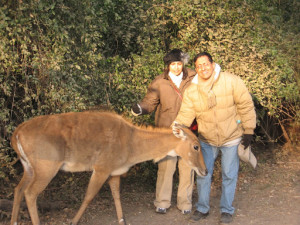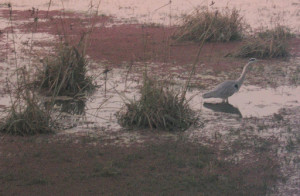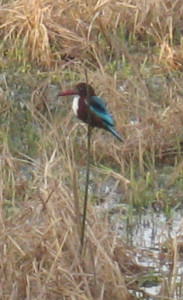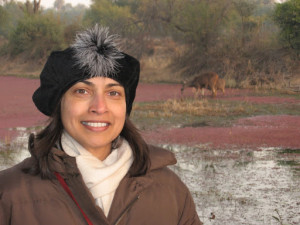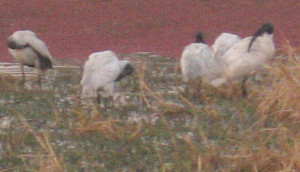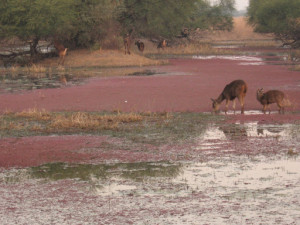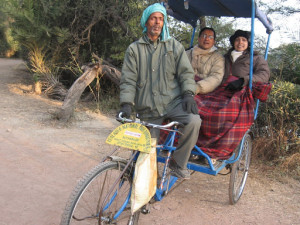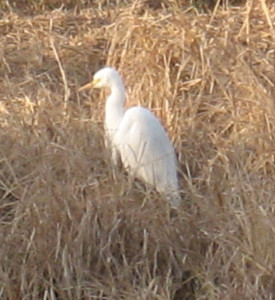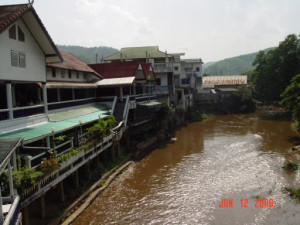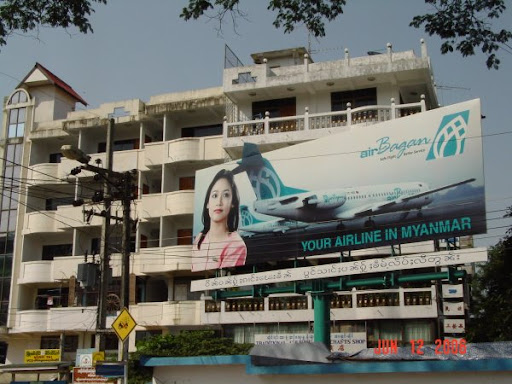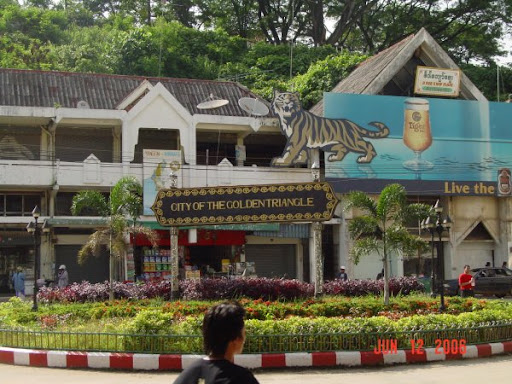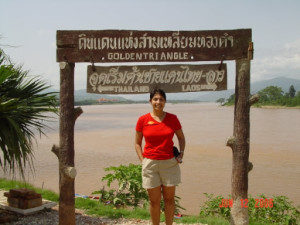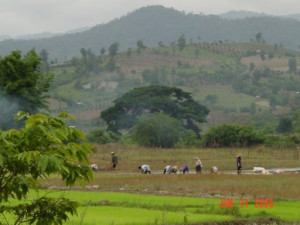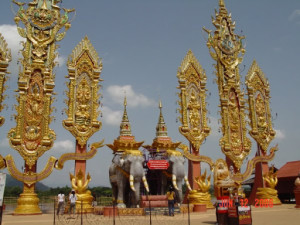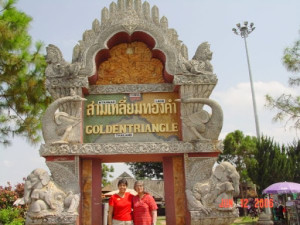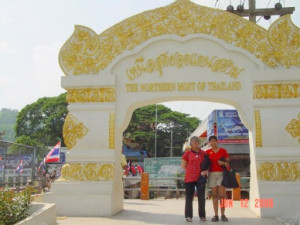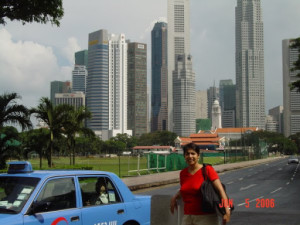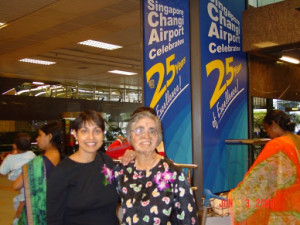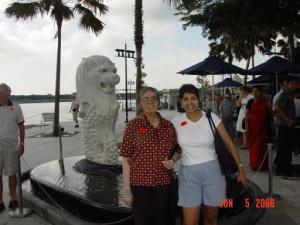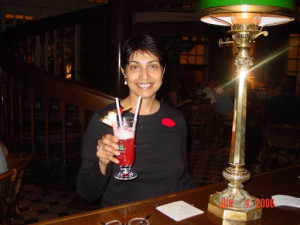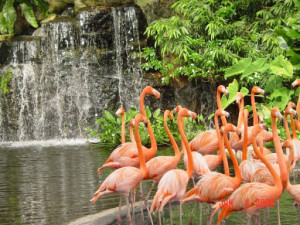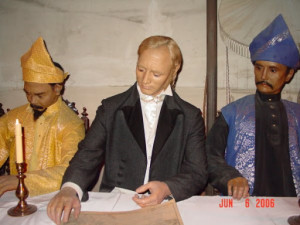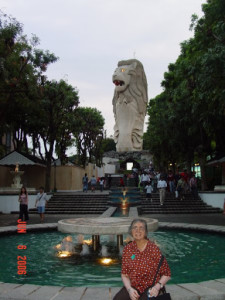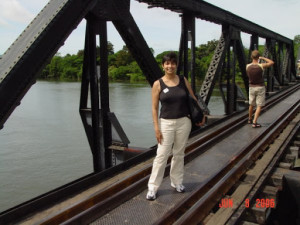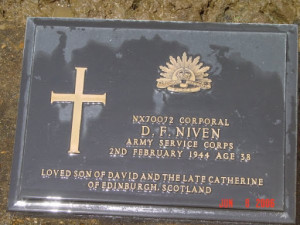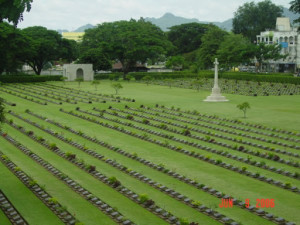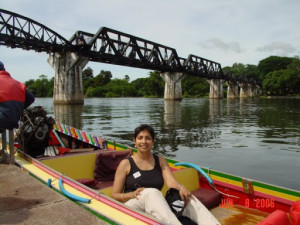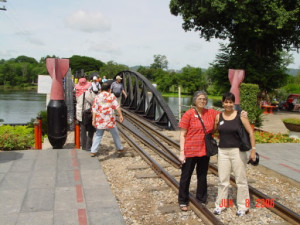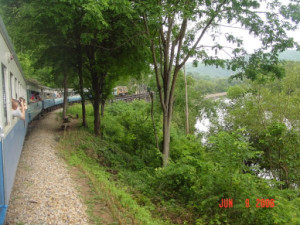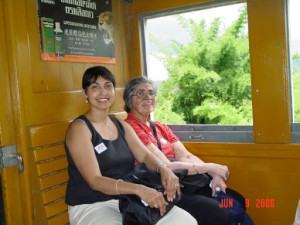(Traditional Thai farmers seen hard at work in the rice paddies iof Northern Thailand)
Then we flew north to the Lanna town of Chiang-Mai, referred to as the “Rose of the North”. A much quieter town that Bangkok, Chiang-Mai is full of local color and character, most of which comes from the number of hill tribes for whom the northern mountain chains have been home for centuries. These colorful people, members of the Akha, Lau, Lisu, Padong, Karen and other tribes, still wearing their traditional costumes, crowd the markets, hawking their wares in the form of wooden and lacquer handicrafts, toys, cotton bags and silverware.
Our base in Chiang-Mai, the beautiful Hotel Empress (left) on Changklan Road, was a dream and as we entered its marvelously elegant lobby, we felt a sense of luxury settle about our shoulders. It was in Chiang-Mai, a much more relaxed leg of our journey, that I found the time to take soothing dips in the hotel pool and relax by the poolside.
Everyone had told us about Chiang-Mai’s colorful Night Market and we explored it on our first day in town, buying a lovely array of silk and cotton garments, local Thai wooden toys, beautifully luxurious Thai silk scarves and lacquer bangles from the local folks. The markets also held a variety of footwear, silverware, wall hangings and other decorative items. Bargaining was a required skill in negotiating the best prices and, before long, we became rather adept at it ourselves.
For both nights that we spent in Chiang-Mai, we ate dinner at the Night Market, feasting on cheaply priced Vietnamese Pho (a noodle soup that is a one-dish meal), Chicken and Pork Satays served with spicy peanut sauce and large Prawns Grilled with Garlic and Pepper to create tongue-tingling flavors that we washed down with the very good Thai Singha beer. There were also a number of fresh fruit juices easily available including the exotic passion fruit juice and refreshingly cold coconut water that was obtained by sipping from “young coconuts” through a straw.
Chiang-Mai’s biggest tourist attraction is Doi Suthep (left), a Buddhist wat situated high up on a mountain that is approached by a narrow winding road. Our guide Nong with whom we drove up to the heights of the mountains showed us the solid gold chedi or pagoda, the gold-filigreed chatris or umbrellas that flank the four corners of the chedi, the ornate wihan, fragrant with the burning of joss sticks and many replicas of Buddhas in various graceful poses. The decoration of this wat was so spectacular that one didn’t quite know what to notice.
Most striking of all the images that one encoutners in Doi Sutep is the Emerald Buddha (left), a replica of the one found in the Wat attached to the Royal Palace in Bangkok. Flanked on both sides by more ornate statuary, this Buddha is one of the most sacred of the guises in which the Buddha is found in Thailand. The air was fragrant with joss sticks as we walked around to see the Buddha from every angle.
There is an interesting legend that surrounds the construction of this temple. King Ku Naa of the 13th century placed a relic from the collarbone of the Buddha upon a white elephant’s back and set it free to select the spot upon which a stupa would be constructed to house the sacred item. The elephant left Chiang-Mai and started its journey, climbing the highest reaches of the Doi Suthep mountain. After three days and nights, he signaled the spot by trumpeting and turning thrice and then fell down and died. King Ku Naa not only built the stupendous gold chedi to house the relic, but he also created a replica of the white elephant to be honored by generations of devotees. Today, thousands of pilgrims climb Doi Suthep by using the magnificent Naga or Snake Staircase that has 360 steps to the top. For the benefit of those not wanting to make the climb, there is a funicular railway which, for just 20 baht, will whisk you up to the top in minutes.
I used the funicular to get to the peak, but took the staircase on the way down, astonished by the thousands of colorful ceramic pieces that gave the staircase its color and durability. Temple bells were seen in abundance around the wat’s precincts and prayer wheels were turned by the faithful each time they uttered a prayer. Everywhere in the north, the heart of Lanna territory, beautiful doors carved in expensive teak wood feature Lanna dancers with elaborate head-dresses and fine costumes. We enjoyed the views of Chiang-Mai from the top of the mountain and the mist-shrouded hills on the way up and down made the entire trip highly evocative of Thailand’s past. At the foot of the mountain, we took a side trip to the Orchid Jade Factory where we watched a film on the selection and cutting of jade for the creation of decorative figurines and jewelry and saw skilled artisans at work.
Deciding to see the rest of Chiang-Mai on our own, using local transport, I summoned a tuktuk driver to pick us up at our hotel to take us on a city sight seeing tour. He arrived on schedule and despite the fact that communication was problematic everywhere, he performed very competently indeed showing us the ornate Wat Phan Do, the ancient ruins of Wat Phra Sing, a monk’s initiation ceremony at Wat Chedi Luang and the beautiful Wat Chiang Man whose chedi is surrounded by stone elephant heads. Interestingly, the wihan houses two tiny but very significant statues—the Crystal Buddha dating from 2,500 years and a Marble Buddha dating from 1,800 years. Stopping only for lunch in a tiny restaurant where we sampled Northern Thai cuisine, influenced greatly by Burmese cooking styles, we ate Green Papaya Salad seasoned with Thai Nam Pla or Fish Sauce and Glass Noodle Salad with Chicken Sausages.
Then, Nim, our tuktuk driver took us to see the amazing number of handmade crafts for which the area is known. We started off by exploring the Thai Silk Village where we saw the incredible creation of pure silk from the very first stage to the last. We witnessed tiny silkworms feeding on mulberry leaves, spinning cocoons in which the eggs are laid but not allowed to hatch. As live silk moths fluttered around us, we saw how the cocoons are harvested. After the silk fibers have been spun around the cocoons by the worms, human beings spin them into spools of pure silk thread that are finally woven on hand looms into lengths of pure Thai silk. The entire process was so fascinatingly described and demonstrated that by the end of it we fully understood the time, effort and backache that goes into the making of a single silk scarf or shawl. Needless to say, silk products were on sale at hefty prices, most of which we passed up completely.
Our next foray was into a gems cutting factory where we saw the manufacture of expensive jewelry and wall pictures. Finally, Nim took us to a handicrafts outfit where we watched the making of Thailand’s traditional umbrellas from rice paper that is painted and then lacquered and used for interior decoration as wall pieces. Everywhere we went, we were treated with the utmost courtesy and made to feel like valued guests in the finest traditions of Eastern hospitality. Indeed, our four hour tuktuk ride that cost us a mere 300 baht provided far more atmosphere that would an air-conditioned vehicle and we were glad we opted for this method to see Chiang-Rai, its noisy Warorot Market and its canal that runs the length of the city and was built by King Meghrai to keep out Burmese invaders.
Chiang-Rai—Last Leg of our Travels:
Our next long excursion was to Chiang-Rai which we reached an hour later. Upon reaching the city, we were delighted to find that our accommodation was the exclusive Legend Boutique Resort and Spa on the very banks of the Mee Kok River in an absolutely idyllic setting. Our “room” was an individual villa with its own patio that came complete with swing and garden furniture. Sinking into the air-conditioned luxury of our room, we treated ourselves to the tea and coffee thoughtfully provided and later went out in search of dinner to the lovely wihan-style dining hall where we partook of delicious dishes that were very comfortably priced as a Country and Western singer strummed his guitar and sang some old favorites for our listening pleasure. We were sure we would have a totally luxurious time in this spa hotel and we planned to treat ourselves to the relaxing pleasures of traditional Thai massage offered by the well-trained masseuses in the spa. We made appointments for the next day and went to bed under the romantic drapes of mosquito nets that hung from four poster beds.
Our excursion, the next day, by local bus transport for just 22 baht each, took us to Doi Tung, a mountain resort that was chosen by the Queen Mother as the spot upon which to build a Swiss-chalet style house and English-style country gardens reminiscent of the home in Switzerland in which she had lived for many decades and raised her children. At the foot of the mountain, we transferred into a mini-bus that for just 75 baht each took us up to the mountain and back. We were joined by two English sisters, Donna and Tanya, who shared our vehicle and talked to us about their wide travels in South East Asia. Once up on the mountain, my Mum Edith and myself, both passionate gardeners, lost ourselves in the wonders of the Mae Fah Luang Gardens (ab0ve left) which were in full bloom and created such a spectacular set of sensuous delights. We took countless pictures among the coleus, dahlias, roses, hollyhocks, orchids and petunias that were planted in tiers on the mountainside in an absolutely ingenious landscaping design. Sculptures, waterfalls, rock gardens, etc. added to the atmosphere of this wondrous place and made for some very soothing hours indeed. The gardens employ an army of staff to keep them sprucely tended and we saw so many gardeners working like busy bees to make sure that not a petal was out of place in those vast environs. We did not visit the Swiss chalet-like villa of the Queen Mother as we had dallied for long in the gardens.
Then, we were driving down the winding mountain road once again and arriving at the base of the range from where we took another local bus and returned to the city center. A tuktuk ride dropped us back at our hotel just in time for a relaxing swim in the kidney shaped pool and our massages that were administered by very ably trained masseuses under mosquito nets on the river banks. In the expert hands of these women, we relaxed our cares away, closed our eyes and gave ourselves up to a pampering that included acupressure techniques and yogic poses in the ancient traditional science that has been practiced and popularized in Thailand for generations. Later that evening, as we sipped soothing ginger and lemongrass tea, we felt so light—as if the weight of the ages had been lifted from our shoulders.
That evening, our last in South East Asia, we enjoyed more live music in the restaurant as we ate Red Snapper Fillets in Black Bean Sauce over Noodles. Our breakfasts had been so gargantuan in the mornings that we had eaten only very light lunches, leaving ourselves ample opportunity to try out local cuisine at sit-down diners which were always superbly cooked and presented.
Conclusion:
Our visit to South East Asia was a wonderful introduction to a culture that was completely alien to us. We learned a great deal about the rituals associated with Buddhism and about the attitude of the local people towards religion, modernity, family values, etc. Thai Airways, that we used for our entire trip, were just amazing in the quality of the service offered, the graciousness and kindness of the cabin and ground crew, and the ease with which we transitted through countries and cultures. Because Thailand has never been colonized, the native culture has remained unadulterated by exposure to the West. Thus, English is spoken almost nowhere in Thailand except by hotel receptionists. This, of course, is not the case in Singapore, where English is widely-spoken, though heavily accented. Food, in this part of the world, if you are inclined towards the ferocity of spice and the soothing coolness of coconut milk, is a marvelous conglomeration of flavors achieved through the use of exotic condiments, herbs and spices such as tamarind and lemongrass, galangal and garlic, kaffir leaves and coriander root, not to mention the ubiquitous chillis that come in bright red and green.
As always, it was the desire to please among the local people that impressed us the most. They are proud of their heritage and eager to share it with the rest of the world. Despite what has been written about the tendency to cheat among people in Bangkok, we found everyone honest and straight-forward. There is little visible poverty in this part of the world though there are few signs of affluence. People seem to have the basics—clean air, clean streets and enough food to go around. Water cannot be drunk straight from the taps in Thailand but must be purchased.
In the final analysis, South East Asia provided a feast for the senses. We responded to all the stimulation offered us and hope to return to partake once more of all the promises of this unusual and very fascinating civilization.
Bon Voyage!
